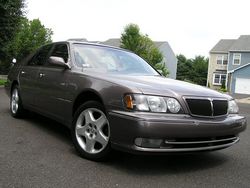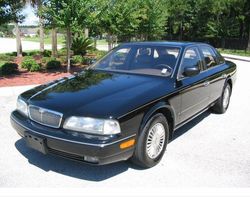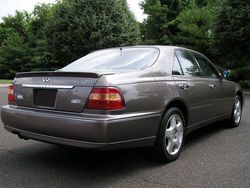.
Infiniti Q45
The Infiniti Q45 is a fullsize luxury car and serves as the flagship of Nissan's Infiniti marque. It is a rear wheel drive luxury sedan powered by a V8 engine. The original Infiniti Q45 was based on the Japanese-market Nissan President (the flagship of the entire Nissan lineup at the time), but later generations were based on the lower-end Nissan Cima. The Q45 competes most directly with the Lexus LS, Cadillac DTS, Lincoln Town Car and Mercedes-Benz S-Class.
First generation G50
The first Q45 came to market in 1989 as 1990 model. Car magazines and reviewers were impressed by the Q45's performance such as a 0-60 mph acceleration time of 6.7 seconds, and its high-output 4.5 L V8 engine rated at 278 hp and 292 ft·lbf of torque. At the time, its targeted competitors such as the Mercedes S-Class, BMW 7-Series, Jaguar XJ and Cadillac Fleetwood had much bigger engines with horsepower ratings in the lower 200 hp range and 0-60 mph times at an average of 9-10 seconds. All Q45 include a VLSD, whereas the LS never did.
One can arguably say that the introduction of luxury performance sedans such as the Q45 and its main competitor, the Lexus LS, had triggered the luxury car market into realizing that fullsize, high-priced luxury sedans should provide better-than-average performance as well as provide luxurious amenities. The short run 1993 included standard first gear start.
In terms of styling, the Q45 was a distinctive vehicle. Infiniti attempted to redefine the modern luxury sedan by offering a car with rather spartan amenities such as firm leather seats instead of cushy couch-like seats and no chrome or woodgrain interior trim. The Q45's grille also shied buyers away with its unusual appearance. A more conventional appearance (including a more conservative grille, woodgrain/chrome interior trim and cushy seats), more sedated performance figures, slower 17:1 steering (except on the Q45t, which retained the original 15.1:1 ratio), and a softer suspension were all added in 1994 to make it a more status-quo luxury sedan. Thicker glass, keyless remote, auto-dim rearview mirror, dipping side view mirrors, an improved transmission heat exchanger and external ATF filter, new oval intake ports and revised disc injectors, lower ratio 1st and 2nd gears, fog lights, and metal backed camshaft timing chain guides were added in 1994.
The Q45 came in three variations: base, Q45t and Q45a. The Q45t and Q45a featured a rear stabilizer bar (with the a model being larger in diameter) and both models having a 1 mm smaller in diameter front sway bar, rear spoiler, BBS forged alloy wheels, and 4-wheel steering. The 1991 Q45 (renamed Q45a from 1992) had the world's first active (actually semi-active) suspension. HICAS and the faster steering ratios was discontinued in the 1995 Q45t model and the Q45a model was not imported in 1996.
Sales never took off due in part to a notorious advertising campaign which did not include actual photos or information about the car. Poor sales were also blamed on the car's unconventional styling. In Japan, this model was later sold as the Nissan Infiniti Q45 rather than the "Nissan President".
The G50 chassis continued in production in Japan until 2002 as the President in both regular and extended wheelbase versions. Many options that never appeared on US G50 were available.
Second generation Y33
The Q45 was moved off the Nissan President platform to the new lower-end Nissan Cima platform in 1997. This Q45 had a more conventional appearance and a smaller 4.1 L VH41DE engine that produced 266 hp (199 kW) and accleration figures of 0-60 in 7.7 seconds (compared to 6.3 seconds for the 1998 Lexus LS). From this model, both the Q45 and the Cima were merged together. The all-multilink suspension was changed to struts at the front end, and was further tuned for comfort. The steering slowed down even more to an 18.5:1 ratio. None of this did much to help the car's sales; Q45 sales in the North American market remained much lower than sales of its primary competitor, the Lexus LS. Traction control and a VLSD were standard.
The 2000 Q45 Anniversary Edition was the highest trim level available for the second-generation Q45. This trim level was standard on the 2001 models. The Q45t was the most expensive vehicle in the Infiniti (excluding the AE for 2000) lineup and offered enhanced performance, a rear spoiler, heated seats, dynamically adjusted shock absorbers and other luxurious features not available in a standard Q45.
The car's appearance was slightly altered for 1999. For this year, HID headlights were added and the analog clock returned. Minor styling changes were made to the front and rear fascias. 17" wheels and an electronic adjustable suspension became standard on the Q45t. Numerous safety improvements in 1998 model were augmented in the 1999 and 2000 models.
Standard features for the second-generation Q45 included a leather interior with exotic woodgrain trim, but no dual climate control, a Bose audio system with eight speakers with an in-dash single disc CD player, auto dimming rear view mirror, automatic light on and delay off timer, and steering wheel-mounted cruise control and head unit control. Also standard was a memorized adjustment system for the driver's seat and steering wheel. An electronic sunroof and heated seats were available as options.
Third generation F50
2002 Infiniti Q45 The Q45 was completely redesigned for 2002, now based on the new platform shared by both the Cima and the President. This Q45 focused on performance again with a new 340 hp (253 kW) 4.5 L VK45DE V8 engine, gatling gun inspired HID headlights, and sharper styling. The car features a 5-speed automatic transmission with overdrive. Despite good reviews, sales remained poor — just 1129 were sold in the United States for all of 2005.
The current Q45 has received praise from Car and Driver, Edmunds and Consumer Guide. Low sales are attributed not to the car’s overall quality or performance, but to lack of advertising and the debatable prestige of the Infiniti name.
The 2003 was given a number of under the skin upgrades including a new security system, a numerically higher final drive ratio, reprogrammed TCU, and during the year, a satellite radio option. The CD player was now a one at a time feed into the dash.
The Q45 received a number of upgrades for the 2005 model year, including new front and rear fascias, restyled hood and grille, restyled trunk lid, new headlight design, integrated fog lights and LED taillights. Inside were new contoured double-stitched seats, white luminescent gauge markings, chrome accents and dark maple trim. 2005 upgrades also included a recalibrated transmission and new 17" alloy wheels.
The following features are standard in the Q45: all-leather interior, power sunroof, 8-way power front seats, remote keyless entry, rain-detecting wipers and side curtain airbags. Standard electronics include: CD, 8 Bose speakers, trip computer, rear camera parking sensors and a voice-activated navigation system. The 2002 Q45 was the first vehicle to ever offer voice-activated navigation controls.
The car seats five and has a base price of US$56,200.
This F50 chassis and suspension is very similar to the US FY33 (1997-2001 Q45) and Y34 (US 2003-2004 M45).



